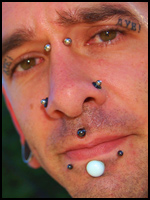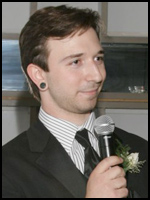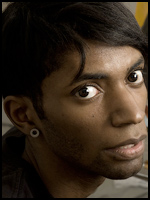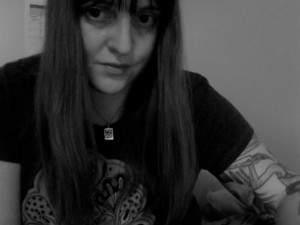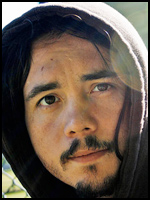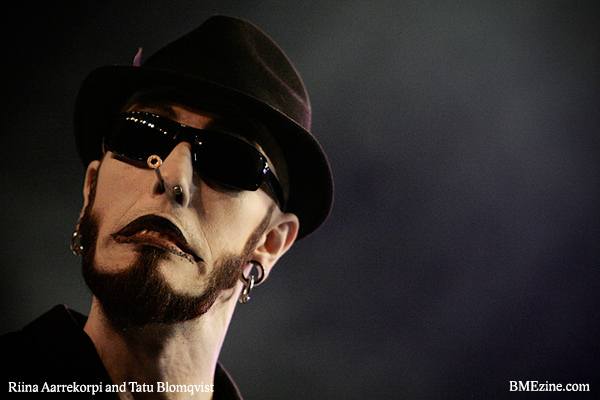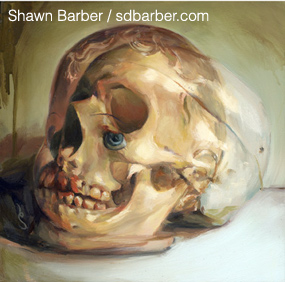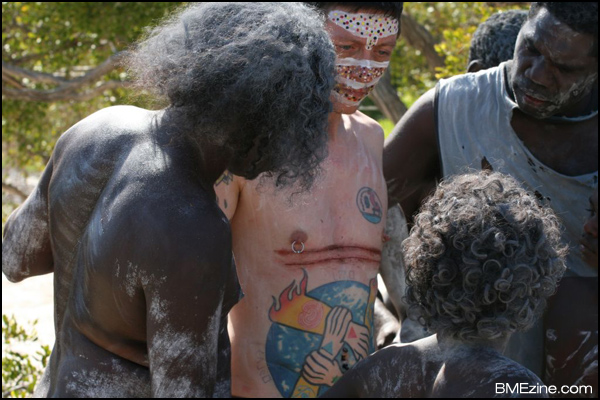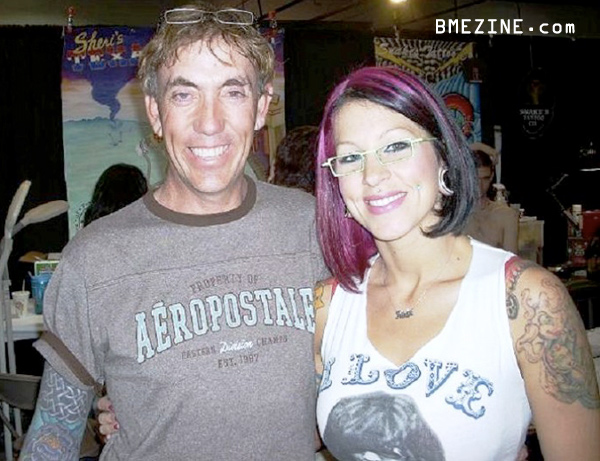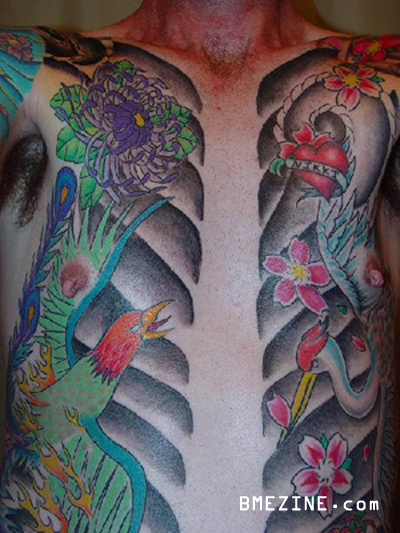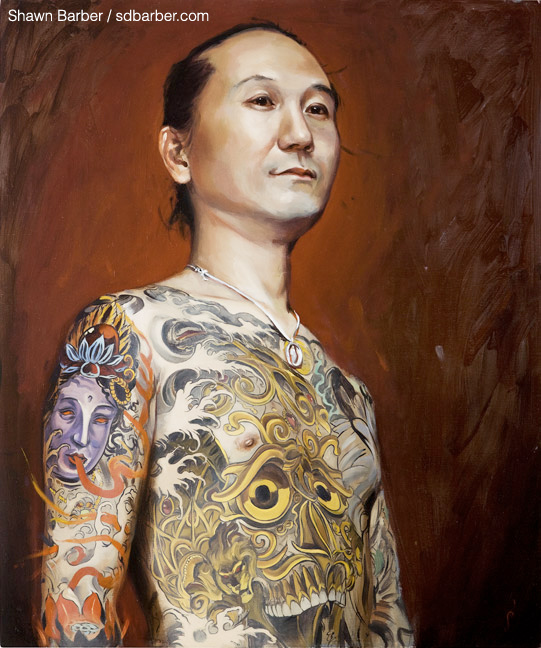
As an art teacher, Shawn Barber had a reputation. Teaching damn-near every class offered at the Ringling School of Art & Design in Sarasota, Florida, his alma mater, and later at the California College of Arts in San Francisco, he was often frustrated — frustrated and disappointed — at what he saw as a lack of dedication from many of his students. Not that they were unskilled, necessarily, but he didn’t see artists: He saw people who wanted others to think they were artists. And so he told them that.
“You should probably drop out now. Save your mommy and daddy some money, and wait. Go to community college.”
He felt comfortable laying that bracing honesty on his students because he could see patterns developing — many of which, for him, began in his own life. Barber himself screwed around during his first run through college, “partying, thinking I knew more than my teachers,” and ended up dropping out and wasting years. “I know who those kids are,” he says, “and I know they’re not doing themselves any favors by putting themselves in debt for no reason other than being lazy.”
It was the responsible thing to do, as far as he was concerned. Most kids, Barber says, don’t even want to be in school. They’re there because they’re supposed to be, or because their parents will cut them off if they don’t go. They didn’t want to produce anything, didn’t want to be told what to do, didn’t want to make progress. Barber felt that he had information to share and wanted to help people get better, “But I don’t want to be somebody’s daddy, I don’t want to be a fuckin’ babysitter, I don’t want to be a fuckin’ psychologist,” he says. And so he quit, in December of 2007.
Nowadays, if Barber’s teaching, it’s often for a different clientele: Tattoo artists. He hits on the order of 15 conventions a year, all over the world, and typically offers a three-hour portrait painting seminar, during which he’ll make a painting before the class while explaining the process and analyzing it as he goes along. This, far more than university-level teaching, is his bag. “The thing with most every tattooer out there,” he says, “except for maybe the last few years, is that many have never had any kind of art training. Maybe a class here or there, but not really art school, or a regimented, rigid, structured environment where you’re forced to make stuff for a number of years. They tattooed either out of a desire to just want to do it, or for money, and most of them are really good artists trying to make the best art they can — on bodies.” One of the results of tattoo artists exploring their options with more formal training, he says, is a greater expansion beyond tattooing and into the world of fine art.
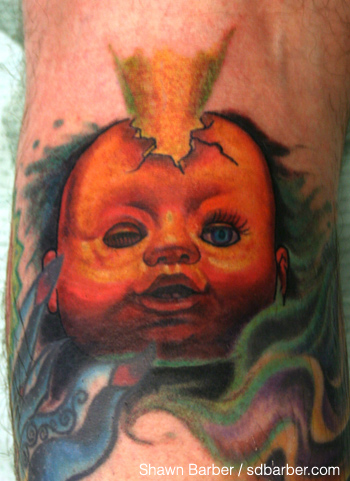 |
Barber, meanwhile, is going the other way. Coming from a fine arts background and well established as a commercial artist, with clients including Rolling Stone, Rock Star Games, Saks Fifth Ave, American Airlines and Converse — “I’m doin’ alright!” he says, laughing — he’s three years into a tattoo apprenticeship under Mike Davis at Everlasting Tattoo in San Francisco, a path he couldn’t have quite imagined when he got to San Francisco four years ago. “I had an idea of tattooing when I was 17,” he says, “but not when I got out of school at 29. It definitely was not the direction my head was.”
Which is not to say Barber was uninvolved with tattoo culture beforehand. He’s been getting work done ever since he laid down for a Spiderman tattoo on his leg when he was 16, and has since become much more heavily covered. Perhaps most notable, however, are his “Tattooed Portraits” — an ongoing series of mostly photorealistic paintings of tattoo artists and other heavily tattooed people, some of which were compiled in a 2006 book of the same name. But even with a pedigree like that, Barber had to start his apprenticeship the way anyone else would — cleaning up everybody’s shit, setting up appointments, making needles, putting together tattoo machines. Even still, it may not have worked out so well were it not for the shop itself, and specifically its owner, Mike Davis, who is also a painter. “It just made sense. A painter who wants to tattoo, and a tattooer who paints. We just kinda connected, and could help each other out.”
In January of this year, Barber finally started charging customers and taking walk-in clients, currently working out of the shop three days a week, a process that has not been without its stresses for the man who would freely tell his students that they were not meant to be artists. “You’re dealing with so many different elements,” he says. “You have the awkwardness of not knowing the craft, and you have your own personal skills that you bring to the table, but there’s still this uncertainty, and you can’t commit to something permanent without being confident, or else that’s going to show. So it’s that balance between those two fuckin’ completely different dynamics. But when it works? It’s fuckin’ super cool. It’s really exciting.”
He’s not at the point where he’s trying to establish himself as the go-to for a certain style — “I’m not sure there’s anything I’d say I’m really proud of yet,” he says, laughing, “but maybe a few things that I’m happy enough with.” Though he does lean towards the subject matter of his non-tattoo art somewhat, working with mixing realism with traditional tattooing — heavily graphic with a lot of rendering, perhaps, but also graphic in the understood sense of tattoo tradition, and playing off of those two.
Oh, and skulls. Lots and lots of skulls. “Skulls are always cool tattoos, man,” he says. “You can’t really go wrong with a skull.”
While Barber may not be the first fine artist to transition into tattooing, he may well be emblematic of a developing trend, and he giddily describes this current era of tattooing as a “renaissance.” Now, more than ever, he says, tattooing is not the rogue operation it once was, and is even becoming a desired destination for students of fine art once they leave school. “I even had a few students in the past that were already tattooers,” he says, “working for a couple years, and they were doing both full-time school and tattooing professionally. That’s some fucking commitment, you know?”
These eras of exciting advancement and evolution come in waves, he says, maybe every ten years or so. He refers to the ’90s in San Francisco, to Ed Hardy and the emergence of others over the years: “You used to have a couple pioneers, and then there were a handful of pioneers. Now? It’s like a fucking tsunami or something.” Another upshot of this, he believes, is the (hopefully) friendly competition it’ll stoke — if the newcomers are highly trained, it should inspire the established artists to get even better, right?
Well, to a point. If there is a backlash, it’s likely to come from the older generation, he says, those in their fifties and sixties and beyond, who are so entrenched that the idea of formal art training may be something of an insult. When discussing this, Barber frequently breaks to ensure that he’s not coming off as condescending or a dick — his respect and admiration for the craft and his forbears is obvious in his trepidation when broaching a subject that could in any way be construed as negative towards the pioneers of the industry. So when he speaks of the “crudeness” of style of some of the older artists, it’s not a criticism; it’s a uniqueness and charm that Barber loves, but it’s also probably true that many of those artists don’t feel like they need to get any better. And collectors like Barber could not agree more. “Tattoos don’t necessarily have to look like the best thing in the world to be some of your favorites,” he says.
Example?
“I have a shit-house on my leg,” he says, “an outhouse” — the calling card of an old-time L.A.–based tattoo artist, Tennessee Dave. Dave recently required cornea surgery, but without any health insurance, was going to be in a tough spot, so a number of artists got together to raise money for him. Barber painted a portrait of him that was sold on eBay, with all of the profits going to Dave, and as a token of gratitude, Dave tattooed one of his famous shit-houses on Barber. “It’s a fucking cool tattoo,” he says,”and it reminds me of this moment in time, and it’s something we both could share. It’s pretty rad. And at the time he was working with one eye!”
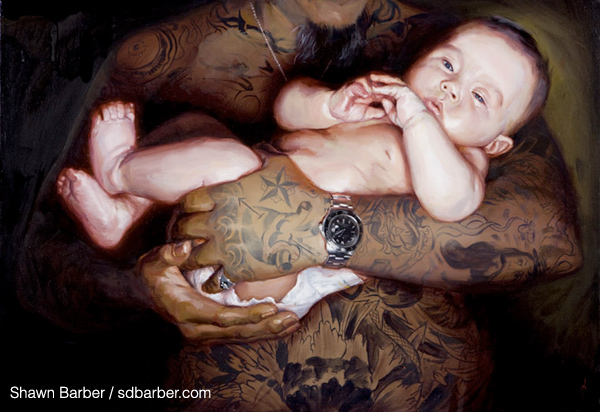
As much as Barber may represent a certain skill-set–related shift, he seems to hold dear many of the culture’s customs, deriding legislation that forces new tattoo artists in some states to attend “tattoo schools,” or makes established artists earn some sort of accreditation. “It’s not necessary,” he says, “Why wouldn’t you stick with the traditions that work? The apprenticeship system works, and it’s a tradition that shouldn’t get lost. It’s a very human occupation — you’re dealing with humanity.”
Nonetheless, he acknowledges that the premium on tradition in the tattoo community can lead to some resistance with regard to any changes at all, be they positive moves or the government just trying to bilk artists for cash. The industry, he says, has just been closed for a long time.
“But,” he says, “it’s also self-sufficient, it’s self ruling. There are standards that just about everybody applies to themselves. And they’re very careful. They know all the bloodborne pathogens stuff, and they do things the right way … though there are a lot of fools who don’t, and things will come back to bite them in the ass. A lot of shops don’t even have people fuckin’ sign a waiver. Crazy.”
As much of a part of the tattoo community as Barber is feeling, though, he still just considers himself an artist above all else. He paints every single day, at least six-to-eight hours a day — sometimes more. Even being on the road at conventions and gallery showings upwards of 15 days a month, he’s still sure to bring his equipment with him no matter what. Sometimes it’s an 8-inch-by-10-inch piece that he can burn through in a few hours, while others may be 80-inch-by-60-inch monsters. All told, he typically produces about 80 pieces a year, and claims to have painted over a thousand over the last ten years, all of which are made to show in galleries, and most of which are sold. (Or traded, either to tattooers, other artists, or galleries themselves.)
The medium for Barber seems almost inconsequential. Although he can see himself moving up to working four or five days a week as a tattoo artist, he refuses to say that becoming a full-time tattoo artist is the goal. “The goal,” he says, “is to become a better artist, both as a tattooer and a painter. Those are my two passions.” The satisfaction that comes from completing a tattoo is near identical to the feeling of finishing a painting, he says — art is art. And almost without exception, his reception from the tattoo community has been positive. “Unless I don’t know about it,” he says, laughing. “The haters don’t come out. You don’t always necessarily know who hates you. I don’t have time or energy for those people. If they hate me, they don’t know me. Most people hate because their lives are so shitty they don’t have anything better to do than talk shit. It’s just a waste, man.”
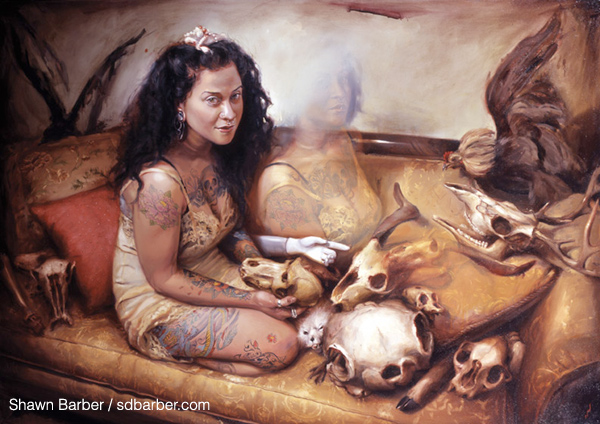
Upcoming Art Showings:
– 3 person show at Last Rites Gallery in New York City, December 2008
– Solo show at The Shooting Gallery in San Francisco, 2009
– 2 person show at Yves Laroche Gallery in Montreal, September 2009
– Solo Show at the Joshua Liner Gallery in New York City, 2010
– Solo Show at Billy Shire Fine Arts in Culver City, 2011
Upcoming Convention Appearances:
2009
– Feb-March: Musink, 25 City US Tour, Tattoo Convention with Social Distortion and others
– May: Rome, Italy Tattoo Convention
* * *
Please consider buying a membership to BME so we can continue bringing you articles like this one.

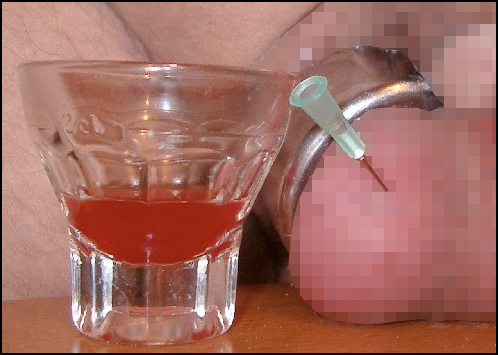


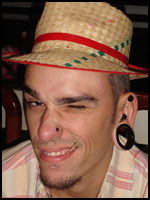
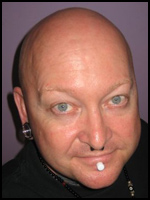


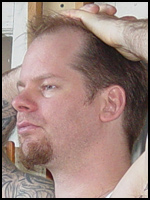
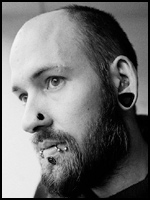
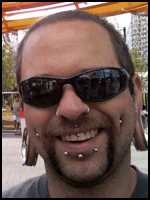
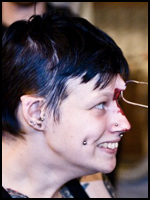




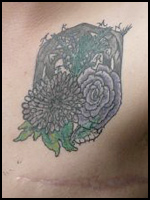

 Metal Faced Yazzy
Metal Faced Yazzy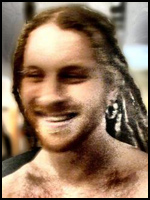
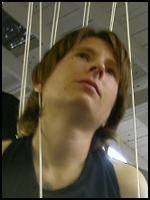
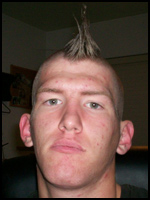
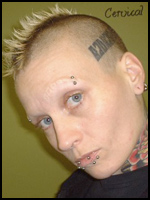


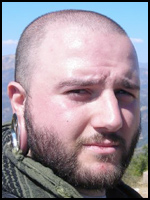
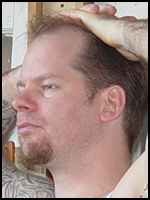

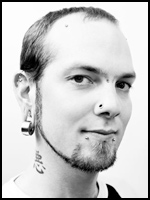

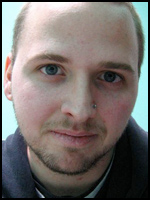
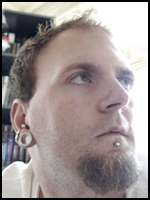

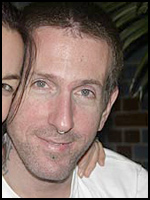



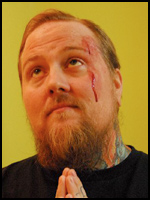
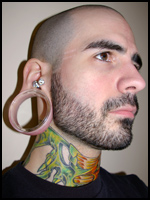
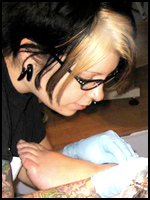

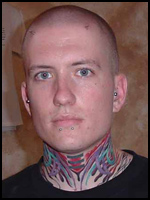

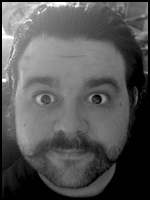

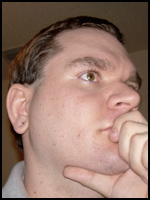 Jason Cartwright
Jason Cartwright